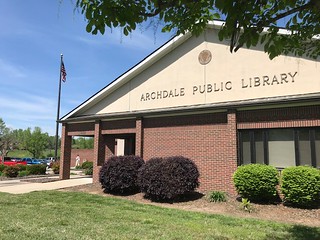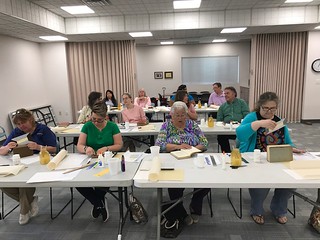This article is more than 5 years old.
On April 24th at Archdale Public Library and April 25th at Sheppard Memorial Library in Greenville , I taught back-to-back book repair workshops. These workshops are sponsored by the North Carolina State Library and are funded using LSTA Grant funding. The participants are primarily from public libraries and are eager for any knowledge they can get about book repair. In Archdale, the participants came from Montgomery County, Lumberton and Randolph County libraries. In Greenville, I had participants from Pitt County, Edenton, Manteo, and Bladen County.
The audience was very receptive at both locations. This receptivity is rewarding and makes one feel like you are doing a real service to the library community. Most public libraries are under-funded and usually ask a Technical Services person to do the repairs as an additional part of their job. The primary issue is there isn’t much training available. The individuals who attended these workshops were able to learn a lot in a short period of time. In addition, the NC State Library provided a small tool kit with supplies for each attendee which included PVA adhesive, brush, a bone folder, knife, Japanese tissue and heat set tissue.
My idea for these workshops is to start with the easy repairs and move towards the more complex. We always begin with tipping-in a loose page, in which a thin line of glue is placed into the gutter where the page has come out. The page is then re-inserted and placed under a weight to dry. We then begin mending paper tears with heat-set tissue. Heat-set tissue is an archival tissue with a heat-sensitive adhesive on one side. The tissue is torn so that it overlaps a tear and heated into place using a small iron.
Following this, I cover tearing Japanese paper and using it to re-attach broken joints, which are usually at the beginning or rear of a book. Japanese paper is torn against a ruler because a torn edge is softer than a cut edge and lives in the book better over time.
I spend time before and after the lunch break walking the participants through replacement of a damaged spine. The includes many small steps, none of which are difficult. In this procedure, we remove the damaged spine and make a new spine piece. This new spine piece is inserted under the book cloth, glued into place and pressed.
I also demonstrate paperback repair, repairing corners and replacing end-papers to strengthen a book.
I try to point out inexpensive ways to get the job done and offer advice on repair methods that are possible on a budget. I hand out directions for making a simple book press and emphasize the usefulness of a simple cloth-covered brick as a weight. Who knew a brick could be useful outside of the architectural realm?
These workshops are always fun and very positive. Everyone appreciates the tips and goes home with a book repair kit and handouts to reinforce what they learned. I look forward to the next series of workshops.






7 Comments on ‘Spring 2019 Book Repair Workshops’
Craig, this is all kinds of awesome! Thanks for sharing! (and for doing this good work!)
Thanks for sharing. Informative. Mending the broken, heated set tissue gets the job done.
I love imagining how many books get a little TLC after each workshop – thank you for sharing about your teaching, Craig!
Thanks for this work, Craig, it is so important for NC communities!
Thank you Craig for sharing your experience! Any chance that you will be conducting the workshop over the summer for book enthusiasts? An inquiring mind would like to know.
I’m happy to see such a great turnout for these awesome workshops.
Thanks for explaining the processes and tools in your post!